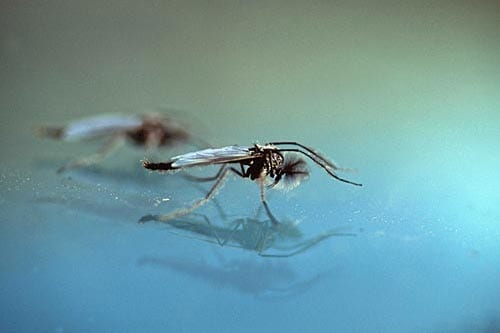
Professor Anthony Ives of the University of Wisconsin found that the population of the midge species Tanytarsus gracilentus grows exponentially until it eats “out of house and home.” It then experiences a population free fall. (Photo Credit: University of Wisconsin—Madison)
As part of the Biological Sciences Department Seminar Series, Anthony Ives, a zoology professor from the University of Wisconsin – Madison, came to Dartmouth to present his findings on the population dynamics of the midge species Tanytarsus gracilentus from Lake Myvatn, Ireland. Ives currently studies ecology, evolution, and the interactions of various species while blending his empirical and theoretical work.
Ives was recruited for this project after presenting his findings on the population dynamics of aphids and the predators and parasitoids that keep the aphid populations in check. He found a tightly coupled predator-prey system that could have either a three or four point cycle, depending on the initial population size, that would repeat itself after every harvest. The data for midges was not cyclic, however; there were huge, irregular changes in the midge population with fluctuations of more than five orders of magnitude.
Lake Myvatn is located near several active volcanoes and hot springs, making this lake an unusual habitat with very nutrient- rich lake water at a pH of ten. After evaluating the experiment, Ives decided to collaborate with the Icelandic team that approached him, and, together, they collected data over 25 years that let them evaluate 50 generations of midges in this lake. These midges are a vital source of food for bird and fish populations, so irregularities in population dynamics could have significant effects for the whole ecosystem.
When trying to explain these changes, Ives looked at the midges’ food source – diatom algae, which live on the bottom of the lake, and detritus, dead organic material. Ives used two key parameters for his population models: resource input of the amount of diatoms that go into the system and detritus retention. The population dynamics shift between two alternative states, one with a six orders of magnitude cycle and another with a high stable point.
With this model, Ives found that midges “eat themselves out of house and home” and then experience a population free fall that is saved by a small amount of leftover food. The midge population then slowly grows, and the diatom algae and detritus can rebuild until the midge population grows too large again. This midge-algae-detritus model accounts for more variation than both the loglinear and logistic model created by Ives and his team, making it the best of the three.
This study was not purely academic, however. It was conducted in response to diatomite mining in the lake, which increases the depth of the lake and creates a hole that Ives believes disturbs the midges’ food sources, which in turn affects the salmon fishery and bird populations. The mine was closed before it could take over the southern basin of the lake because of the high cost and inefficiency of diatomite mining.
Ives and his team recently received a ten-year National Science Foundation Long Term Research in Environmental Biology grant that will allow them to continue sampling midges, algae, and lake water. They will also evaluate how midges, algae, and detritus affect terrestrial and aquatic communities in and around Lake Myvatn.